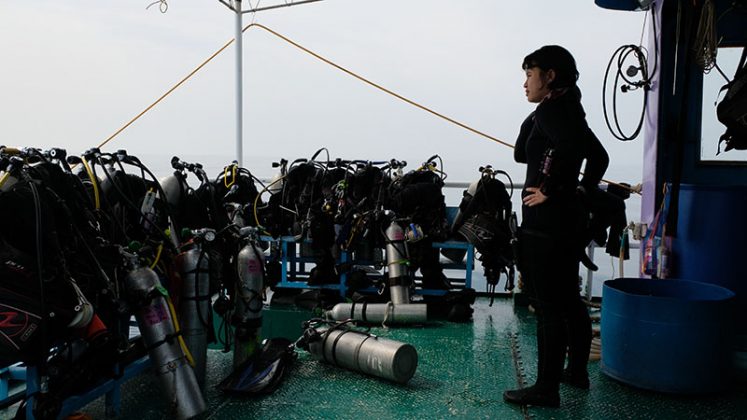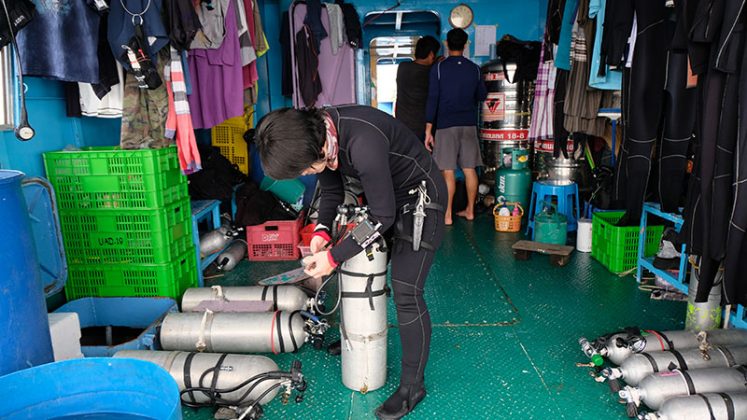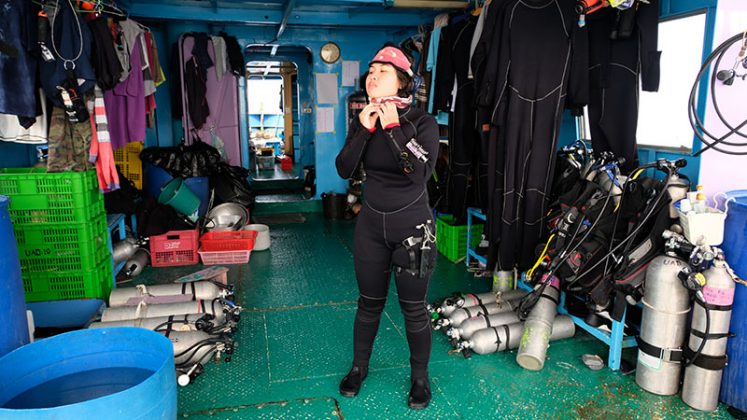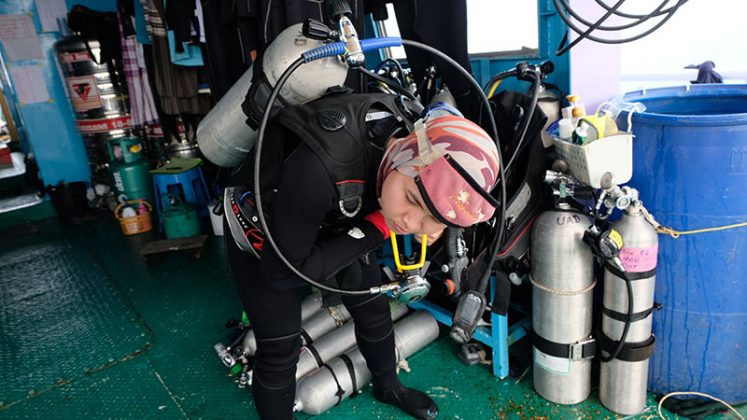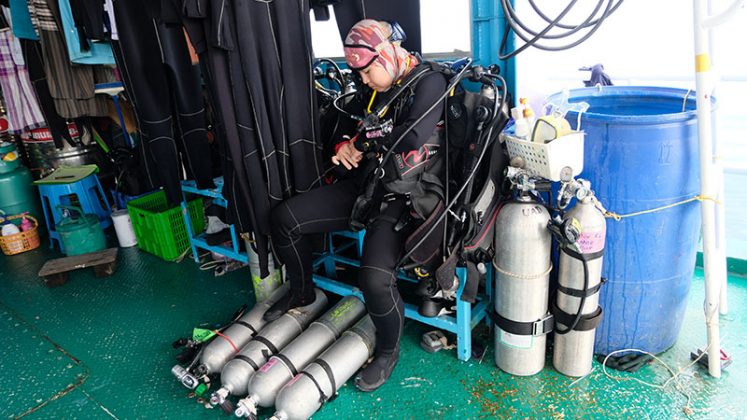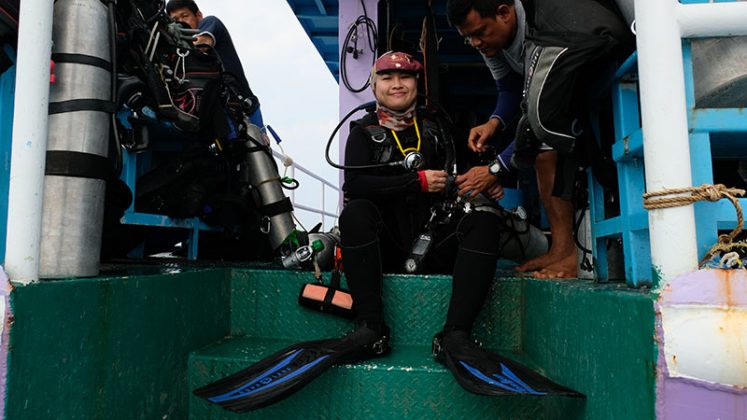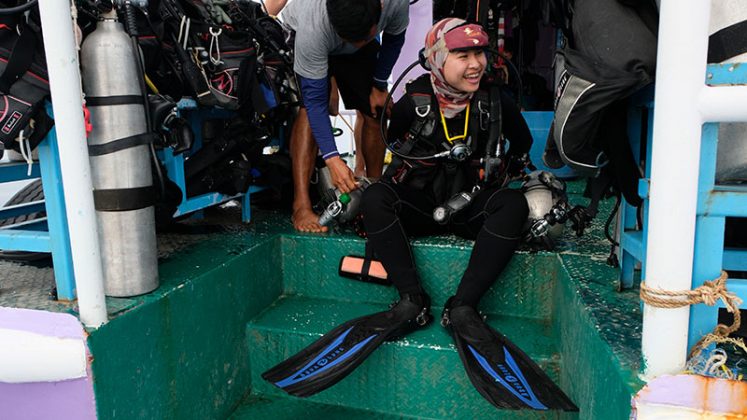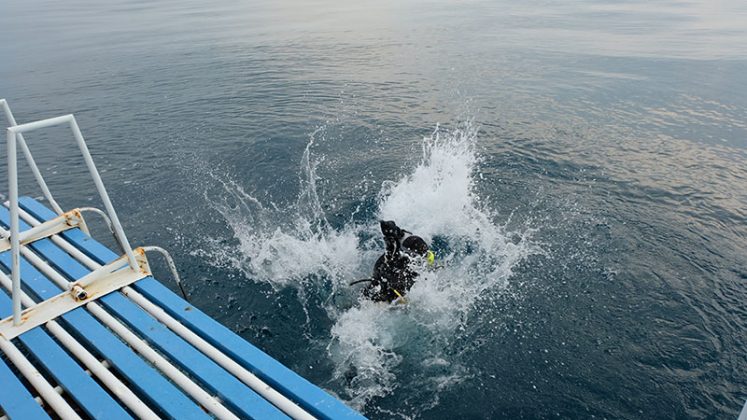A lavender-colored boat bobs off the Chonburi coast, flat ocean all around.
Feet steady on the dock, Jo adjusts the knobs on her oxygen tanks and reads out the numbers. She then straps a heavy tank to each hip and a third to her back with nary a grunt.
Flashing a smile from under a pink camo scarf and goggles, Jo slips her flippers on. She nods to her diving partner, then walks to the platform’s edge.
Deep beneath her at the bottom of the Gulf of Thailand, a shipwreck has rested for nearly a millennium. Jo, now 40 kilograms heavier with gear, will swim down to unearth the secrets it holds to learn the story they will tell.
The assembled crew can all hear her loud breathing through the regulator. She takes three breaths and hops from the diving platform and, with a splash, disappears beneath the steel blue waves.
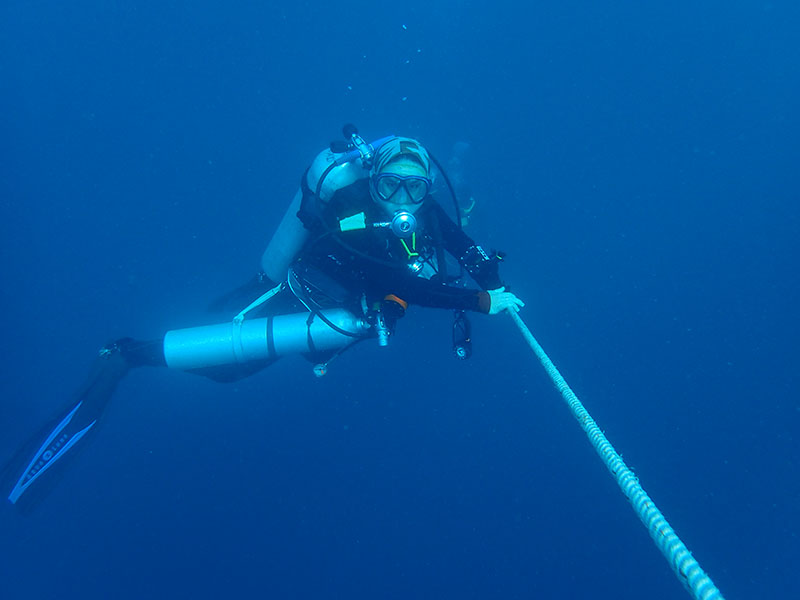
Koh Khram Dive, 8am
Pornnatcha “Jo” Sankhaprasit doesn’t remove her rose-shaped earrings and bracelets before diving. To identify herself down below, the dive computer on her wrist is wrapped in pink duct tape labeled “JOJO.”
Jo is, at 30, Thailand’s first female underwater archeologist.
Watching Lara Croft movies and soap operas about characters discovering hidden, magical ruins, fueled Jo’s keen interest in history and set her on the path to becoming an underwater archaeologist – and Thailand’s first woman one, at that.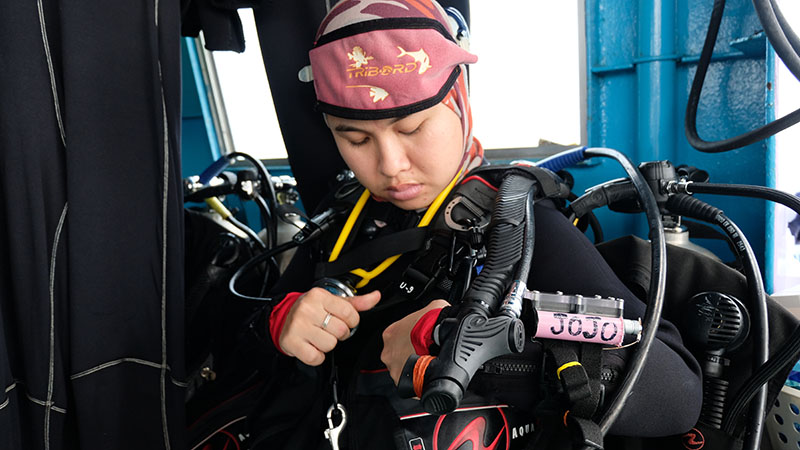
“Those movies really had an effect on me. I thought I would become like the stereotypical cool Lara Croft type,” Jo said.
Her most recent mission has been to study the largest underwater archaeological site in Southeast Asia off the coast of Chonburi with her crew of fellow divers and archeologists.
Sometime between 1350 and 1450 – while the sun was setting on the Khmer Empire – Sukhothai traders, Japanese privateers and Ming Chinese treasure-seekers criss-crossed the seas to Malacca and beyond.
Stormy weather or hostile pirates sank a large junk ship beneath the waves in the Gulf of Thailand.
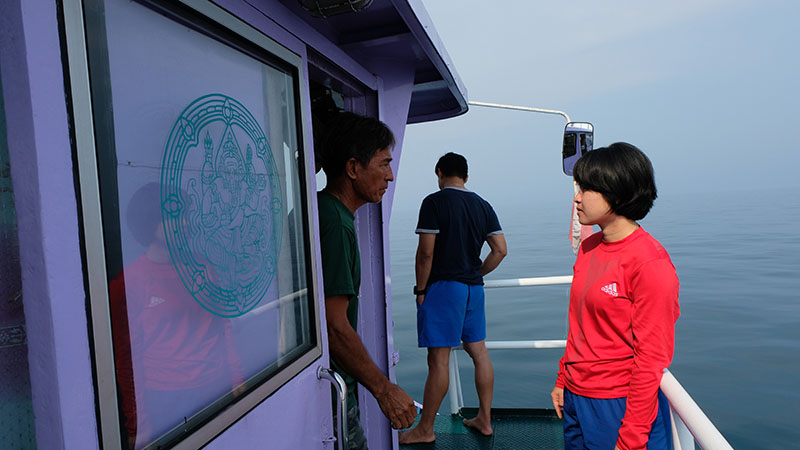
The team believes that buried in sediment amid broken pottery and wood, the ship’s haul of ivory tusks, jars of duck eggs and spices remain intact on the ocean floor.
On a recent day, the Waew Mayura sputtered loudly to a spot past Koh Khram where the wreck lies. After the crew shoved off early in the morning from a marine police pier at Sattahip, the archaeologists prepped for their mission.
“This’ll be the biggest dive of my career yet,” Jo said.
Koh Khram Dive, 11am
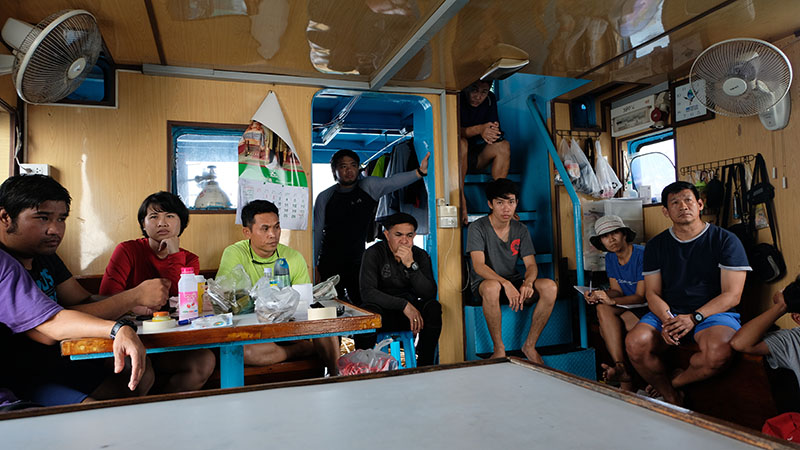
The entire crew gathers for a briefing with expedition leader in the ship’s cabin. Jo’s team has to decide what to bring to the surface and what to leave behind, lest precious items disintegrate upon tasting oxygen for the first time in seven centuries.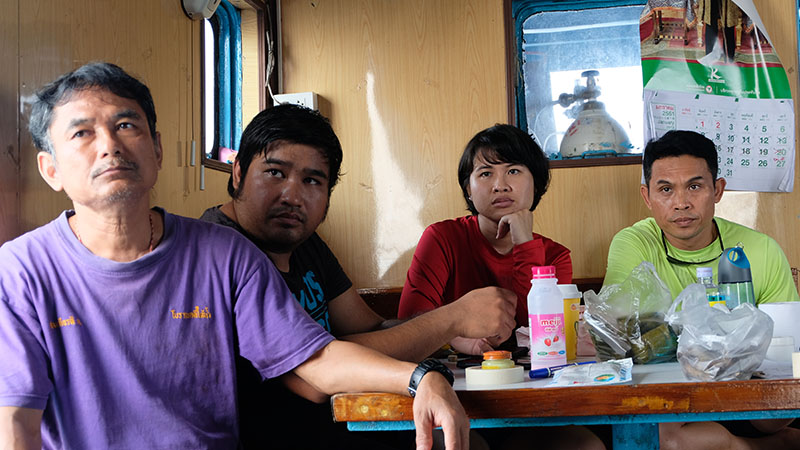
“Don’t call it digging. It’s more like dismantling. Let’s move the pottery to the side and then try to get the digging depth we need today. And be careful with the ivory, its decomposition is advanced and the layers are sloughing off. Be careful not to touch it,” says the expedition leader, Chief Petty Officer 3rd Class Dacha Phonthai.
Tight-Knit Community
Jo said she was lucky that her family supported her career choice, although they were confused about what it actually entailed.
“When my mom heard I was going to work in an arts-related field, she imagined me studying Thai dance,” Jo said.
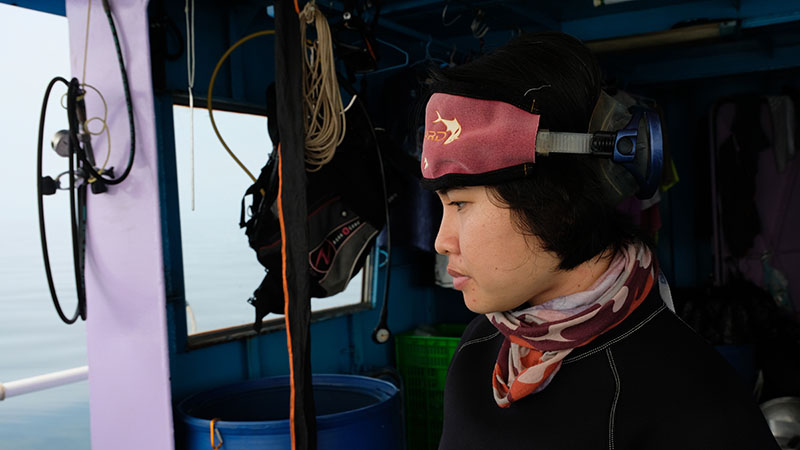 She said she isn’t treated differently for being a woman by the other archaeologists.
She said she isn’t treated differently for being a woman by the other archaeologists.
“They walk around in underwear around me; they don’t care,” Jo laughed. “We’re all like siblings. They don’t treat me like a woman too much.”
An underwater archaeologist is party history buff, part athlete and part Lara Croftian adventurer.
Under the law, Thai archaeologists must have a bachelor’s degree in the field from Silpakorn University, the only such full-fledged program in the country. No other archaeology degrees are recognized.
“The industry is very narrow. We all know each other like siblings,” Jo said.
The culture ministry provides one boat for the nation’s underwater archaeologists: the violet-hulled Waew Mayura.
“Actually, sailors told us boats shouldn’t be painted purple because it’s an unlucky ‘widow’s color,’ but we don’t care,” she said, laughing.
Koh Khram Dive, Noon
Soon after the briefing, the crew drops anchor at a seemingly random spot among surprisingly calm waves.
It may be a science mission, but superstition always runs high on the sea.
“Usually when a stranger is on board, the waves are really high,” Jo says. “Strange.”
Soon the divers are strapping on their wetsuits and tanks and making for the platform.
Pairs of archaeologists and divers go down in shifts of 25 minutes each. The diver holds a PVC pipe that blows air to clear sand and debris. The archaeologist brushes away floating debris to gather data and retrieve artifacts.
A closed-circuit breathing system recycles their air, allowing dives of hours instead of minutes. That’s crucial for a dive of 40 meters.
The other archaeologists on the dive are Sira “Jib” Ploymukda, 29, and Wongsakorn “Pan” Rohothan, 28. Both were underclassmen in Jo’s same faculty. Of the crew of 17, the only other woman is Kanlapangha “Aum” Kiawmas, a 46-year-old assistant archaeologist.
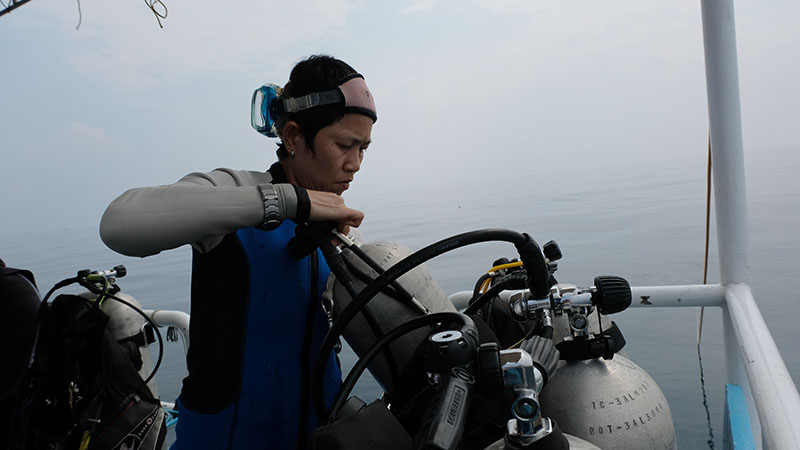
“Being an underwater archaeologist is all about being prepared,” Jo says as she twists the knobs on her oxygen tanks. “It’s not like on land, where you just climb out of a meter-high hole to retrieve a pencil. Here, if you go under without something, you’re dead.”
Jo and the other divers strap on a plastic slate where they can jot with a pencil what they need to do.
“Underwater, everyone is 50 percent dumber. You need to write even simple instructions like moving an artifact to another location down so you don’t forget,” Jo says.
So what’s it like down there?
“It’s not a full ship down there like the Titanic,” Jo said. “It’s in ruins, a piece of wood here and there. You have to reconstruct the ship in your head.”
Passion For the Past
Artifact looters and fishing trawlers boil Jo’s blood.
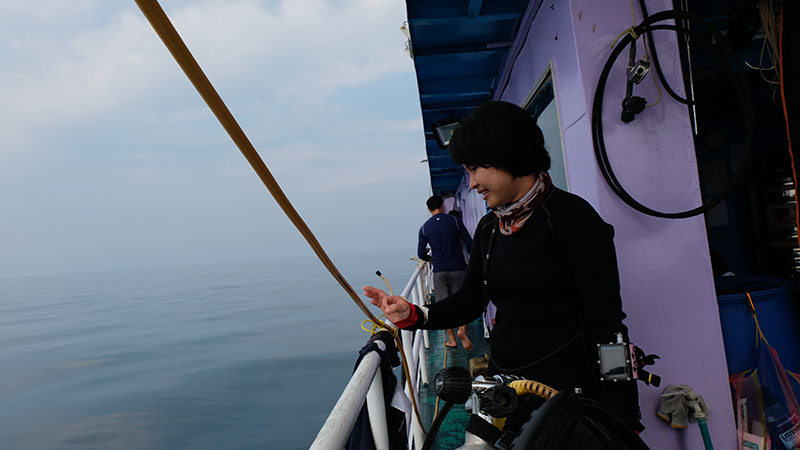 She said that eight-in-10 dive sites, like the Koh Khram shipwreck, are discovered by fishermen whose trawlers comb the ocean floor, smashing centuries-old pottery in the process. Few fishermen report such sites to the navy because it’s tempting to trade an old Sukhothai plate for some cash on the black market.
She said that eight-in-10 dive sites, like the Koh Khram shipwreck, are discovered by fishermen whose trawlers comb the ocean floor, smashing centuries-old pottery in the process. Few fishermen report such sites to the navy because it’s tempting to trade an old Sukhothai plate for some cash on the black market.
“When we find a site we have to hurry,” Jo said. “People in this country haven’t developed an awareness about valuing historical artifacts yet. And we can’t protect them all.”
Jo’s eyes come alive as she uses her hands to describe the shapes of pottery and ivory she has found.
“The ships we find can be Chinese junks, European ships and Southeast Asian junks,” she said. “So we think this dive here is one of those Southeast Asian junks: They’re mutant junks which locals modeled after Chinese junks, but are smaller and more streamlined.”
The shipwreck off Koh Khram still guards its secrets. The discovery of jewelry has whet their imaginations to the possibility it may have been more than a trading vessel.
“The Ayutthaya ships we find are mostly merchant ships, but we found gold jewelry with rubies on this dig. That means this could possibly be a royal boat!” Jo said, bursting with excitement.
And then there’s the discovery of things one wouldn’t think could survive.
People in this country haven’t developed an awareness about valuing historical artifacts yet. And we can’t protect them all.
Saltwater and ocean mud helps preserve organic matter that would have decomposed long ago from oxidation and decomposition if it was on an dig site on land.
“We found fragrant woods and an ivory tusk this wide,” she said, stretching her arms wide. “You would never, ever dig up ivory on land because it decomposes. We also found duck eggs preserved in jars and whole pepper grains too,” Jo spews, her enthusiasm flowing like a powerful current.
Koh Khram Dive, 1pm

As Jo climbs back onto the boat, crewmates move in to help her unstrap her heavy tanks. Post-dive exhaustion doesn’t dull her enthusiasm: She quickly launches into her finds, saying she dug 10 centimeters to find broken pottery, a piece of the wooden hull and some Sukhothai-era tableware.
She’s no newb when it comes to diving back through time to touch history first-hand. She’s gone down to study a rice barge that sailed in the late 19th century under Rama V and foundered in the Mun River in Isaan. Another mission saw her up close with French iron-clad wrecks in Bueng Kan.
“Other people don’t get why we’re so excited about some broken old pots. But it’s funny, I don’t actually like the act of diving. I wouldn’t go diving to see coral. But when I know there’s a dig site below, I willingly dive,” Jo said.
A split-second mistake can cost an underwater archaeologist her life – and the job is risky enough no one will insure them.
“All life insurance companies refuse to take us on. We each just get a 10,000 baht hazard fee per month from the government that basically says, ‘If you die, then mai pen rai,’” Jo said.
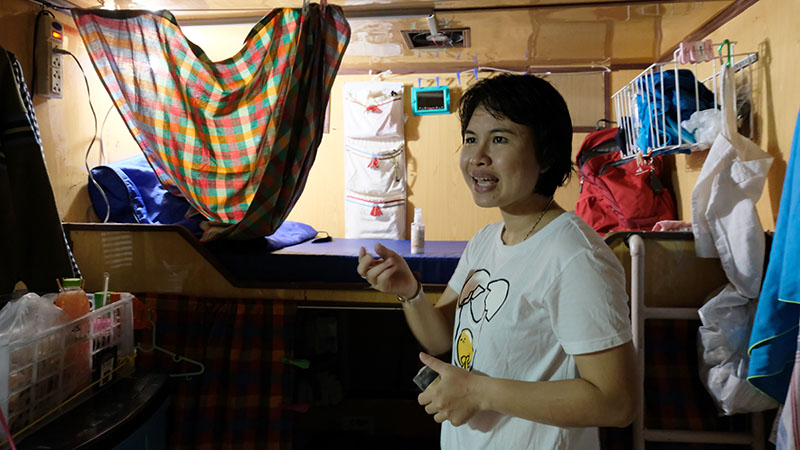
And die they have. A practice pool at the Underwater Archeology Office is named after Detchpirun Seerabutr, an archaeologist who drowned on a 70-meter dive near Koh Kut in 2013.
“That was the only death,” Jo said.
At sea, Jo said there are no hard and fast gender roles on the boat. Still, there are some tasks she notices men and women gravitate toward.
She especially likes categorizing the finds and writing up the academic dive reports.
“It’s not that the men are bad at it, but I can really systematize it,” she said. “We trade off writing the academic reports, but I volunteered to write up this dive’s.”
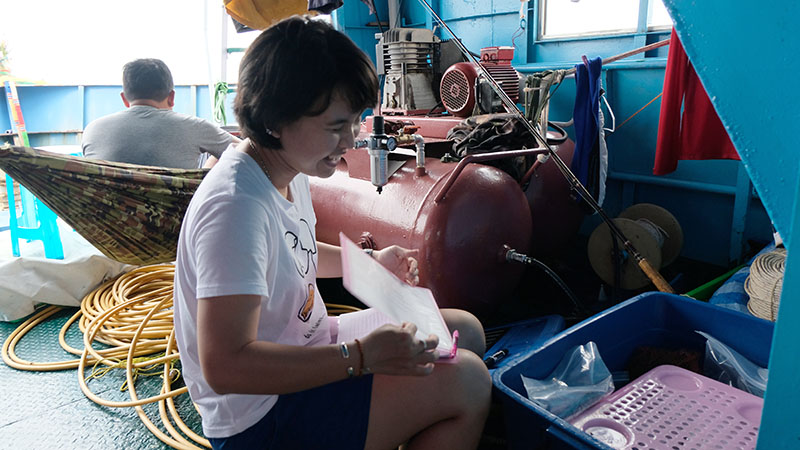
But at sea, archaic superstitions hamper everyday tasks: Crew members tell her a women’s clothes can’t be hung higher than people’s heads.
Nevertheless, Jo finds it important to maintain her femininity. Sometimes, after removing her diving mask, she slaps on a cosmetic facial mask.
“I never think I have to become a guy. There’s a middle ground,” Jo said while dabbing on Korean face cream next to her bunk in the musty brig. “It’s important to moisturize, especially for divers. Sea [rashes] can really mess up your face.”
I never think, ‘If men can do it, so can I.’ I think, ‘I will do the best that I can.’
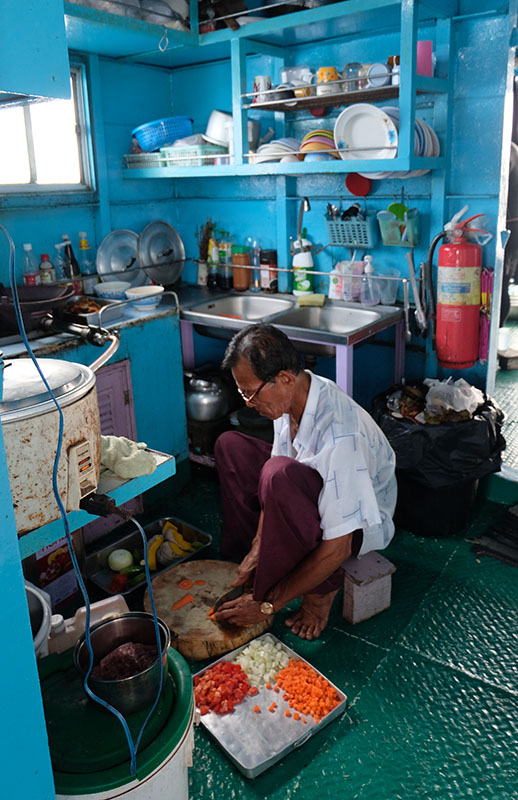
Koh Khram Dive, 2pm
As the divers surface, the ship’s cook fries up several omelettes chock-full of pork and cubed veggies for the hungry historians. The ship pulls anchor and leaves the dive spot before 2pm.
Deflated from the big dive, no one retires to the brig. Most spread out around the upper and lower decks to recuperate and enjoy some well-earned quiet time.
Sharing the small boat with 17 people, Jo marks her stuff clearly with stickers of Gudetama, the anthropomorphized egg yolk Sanrio character.
It was a long and arduous journey from her 2008 graduation to the waters of the gulf.
When Jo began training, one of her instructors strapped two 12-kilogram tanks to her and told her he would not take her as a student if she could not stand up.
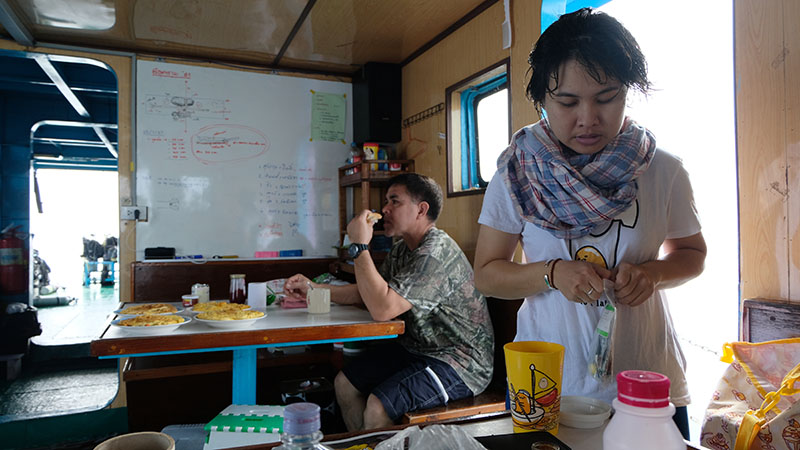
“They trained us like we were in the navy. We’d run at 4 in the morning. On the job sometimes we feel like we’ve used our body to its breaking point,” Jo said. “But I accept my limitations. It’s important to know yourself and not force it too much. I never think, ‘If men can do it, so can I.’ I think, ‘I will do the best that I can.’”
Despite the physical demands the job may have, Jo wishes more Thai women would join her profession.
“I want them to join so much!” she said loudly from the upper deck of the boat. “Most women training to be archaeologists become one on land because they had a bad experience with diving – maybe their air tank exploded, or they went out on a day with bad waves.”
Jo said women also are deterred by the physical demands and fear they’ll be a burden.
“To people who say that they couldn’t survive like this, I say that you can. You just need to adjust,” Jo said. “I want more people to know what I’m doing because I hope I can inspire someone.”
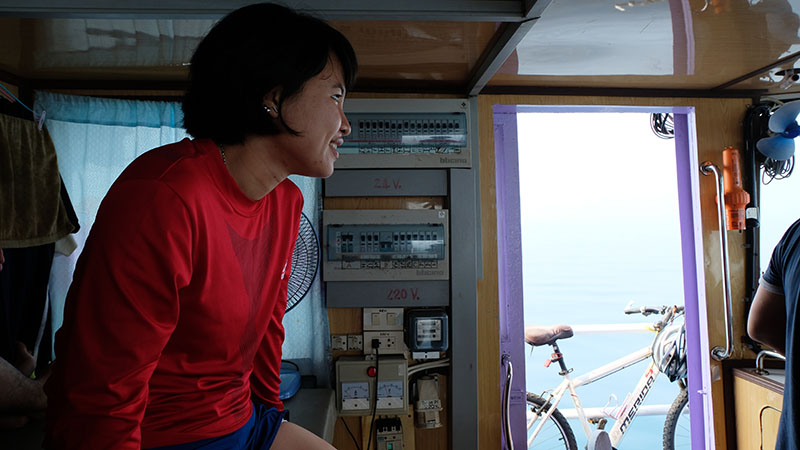
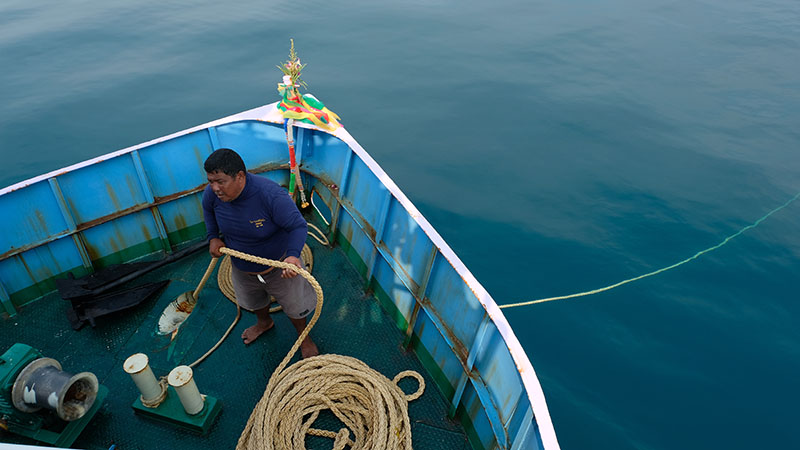
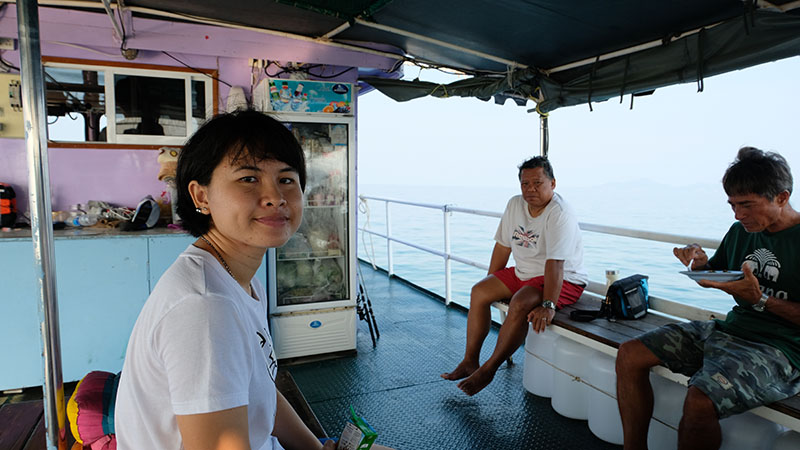
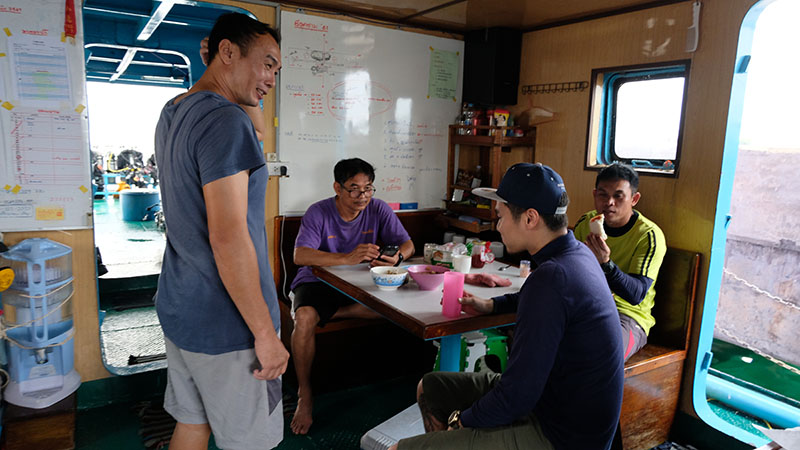
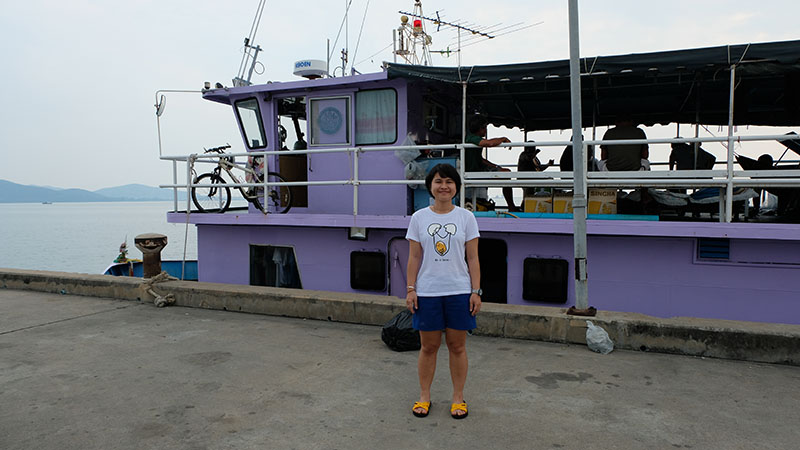
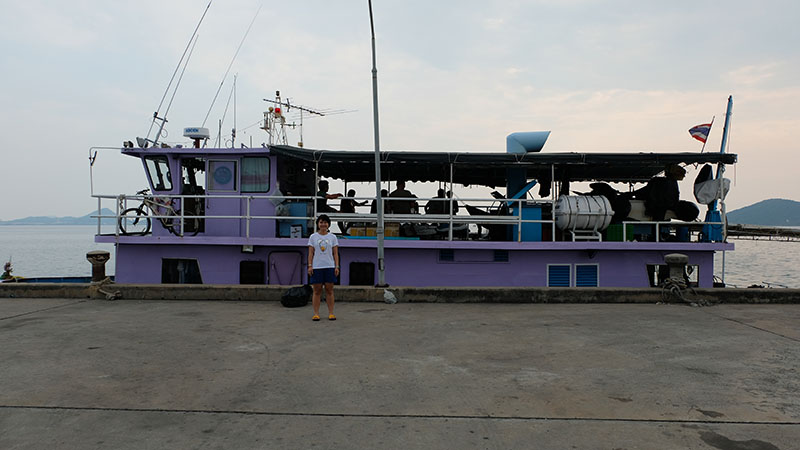
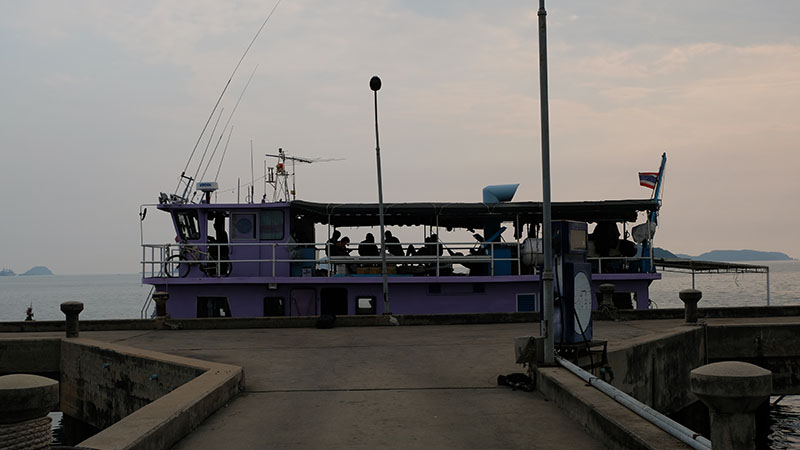
The Fine Arts Department’s Underwater Archaeology activities can be followed at their Facebook, where shipwrecks and underwater sites can be reported to. Sites can also be reported to the local navy.



































